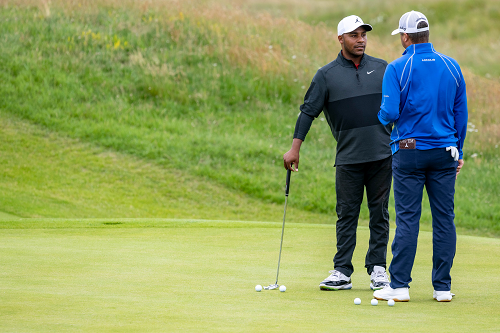

When Baltimore’s Pitch and Putt Golf Club unveiled a monument earlier this month, it wasn’t to honor the historic course (though Carroll Park is venerable in its own right) and it was far more than a kickoff to Black History Month. It commemorated the fact that less than a century ago, the course was one of the few that Black golfers could play.
The plaque, unveiled on February 1, reads:
“Carroll Park Golf Course, a city-owned course, was purchased in 1923 for White golfers only. A group of avid African American golfers challenged the city for access through several legal actions. After much persistence, these golfers gained full access. They were catalysts for opening dialogue with elected officials that resulted in the city of Baltimore granting open access to all public recreation facilities. Around 1938, the Pitch & Putt Golf Club of Baltimore, an African American women’s golf club, was established at the course.”
In very few words, the monument describes what happened. The full story is longer – and more accurately describes the challenges, says The Baltimore Sun.
Jim Wells, the primary author of Separate but Equal? Desegregating Baltimore’s Golf Courses, said Carroll Park, like every other golf course in the city (and perhaps many sports facilities in the so-called free world), was off-limits to Black golfers until 1934 when it fell under the nation’s “separate but equal” policies at the time.
‘Separate but equal’ meant only separate. Play was by no means equal, said the golfers who were permitted to use the course. Carroll Park was nine holes (not 18), was sand greens, had industrial waste at every turn – in other words, it was precisely what was given to Black golfers of the day, including the Pitch & Putt Golf Club.
"We came up with the name because, back in 1938, or before we established as a club, the only thing we could do at courses on Monday, Wednesday and Friday was practice on pitching and putting. We could not play a full game," Stephanie Williams, president of Pitch & Putt Golf Club of Baltimore, told the local NBC affiliate.
Legal action forced officials to begin renovations at Carroll Park, but the cost became so excessive that by 1951, all courses were opened to golfers regardless of race, said The Baltimore Sun.
“Eventually they just decided, ‘We can’t afford this,’ and even when they improved the nine holes, all of the golf courses were desegregated due to the battle at Carroll Park,” Wells said. “And then after that, other facilities like ball fields and swimming pools were all desegregated as a result of this battle.”
These days, such golf courses are being viewed as a microcosm of society – and those who challenged the norms are being recognized for what they endured. After all, it wasn’t like any other city was offering better opportunities – even in the nation’s capital, according to the National Park Service:
As Washington, DC's, park system expanded, new parks and facilities were designated "white" or "colored." In a 1929 comprehensive plan for recreation centers, only six were planned for African Americans compared to 20 for whites. They were placed in predominantly African American neighborhoods, along with segregated schools. Later, in 1924, a 9-hole course opened north of the Lincoln Memorial, opposite the white course at West Potomac.
That course was fraught with as many problems as the Carroll Park course. During the construction of Memorial Bridge over the Potomac (which began around 1929), golfers had to contend with construction debris that was dumped there. One golfer described having to surmount “piles of dirt, pipe, and building materials on the fairways; and such a curtailment of playing space that the entire nine holes does not represent space generally allotted to one hole on the courses provided for the white group.”
That course ultimately closed, and in 1939, when DC’s Langston Golf Course opened, it was one of 20 public golf courses out of 700 in the country open to African Americans. The course did not come to widespread attention until 1940, however, when heavyweight champion Joe Louis played there in July 1940 at the Eastern Golf Association’s amateur championship. Reportedly around 2,000 spectators followed Louis around the course. (Louis was the first person of African American descent to achieve the status of a nationwide hero within the United States – perhaps even more so because he had defeated German champion, Max Schmeling - who, oddly enough, became one of his closest friends later in life).
Across the nation, golf courses are being remembered as a grounds in the struggle to desegregate one of the most strongly segregated sports. But it’s not the courses as much as it is those who played them and what they experienced. Not too far from the state capital in Austin, Texas, the Lions Municipal Course (called “Muny” by all those who played there) became known as the first desegregated course of the south – thanks to a nine-year-old caddie named Alvin Propps, who together with a friend, refused to be shooed off the course in 1950. According to Grounds for Democracy, Taylor Glass, the Mayor of Austin at that time, quickly conferred with members of the city council, and a decision was made not to prosecute Propps or his companion. From that point forward, African Americans played golf at Muny. (Oh, and guess who seconded their move by playing there? None other than Joe Louis).
The golfers at the Muny got off easy; in Atlanta, golfers had to take their case all the way up to the Supreme Court (with an up-and-coming lawyer named Thurgood Marshall) and in a landmark case in 1955, won the ability to play at Bobby Jones Golf Course, a public golf course located on the affluent northwest side of town.
Legal challenges became almost a way of life for those who wanted to play. In 2021, the Golf Channel aired a feature on what became known as the “Brentwood Four,” a group of African-Americans in Jacksonville who won a legal challenge over segregated recreational facilities in the city. The feature recounted the 1958 incident involving Frank Hampton, Edward Norman, Charles Brown and Davoye Brown, who were denied access to the city-owned golf courses at Brentwood and Hyde Park because they wanted to make up one hole of a round that had been rained out on a Monday at Brentwood. (At the time, the city only allowed African-Americans to play Mondays at Brentwood and Fridays at Hyde Park. The foursome was not allowed to complete their round at Brentwood on Tuesday morning).
The Supreme Court in 1962 eventually let stand a Fifth Circuit Court ruling that ordered Jacksonville's recreational facilities desegregated, saying that the exclusion of the men from the golf course violated the 14th Amendment. After that, the course was sold by the city to private interests rather than letting it become integrated. (It later became the headquarters for First Tee-North Florida, where hundreds of inner-city children and youth received golf lessons, academic support and life skills training).
According to Golf Blogger, the sale of public courses to private corporations to continue segregation was an established practice. For example, in 1952, Knoxville, Tennessee leased its course rather than integrate. That same year, however, African American golfers in Houston won a court battle to play on municipal courses. New Orleans opened white courses to African Americans that year while separate courses were being built for African Americans.
But no matter what traditionalists wanted, the ball was in motion and the court challenges never stopped. Throughout the 1940s and 1950s, African American golfers pursued a variety of legal and political options to desegregate courses. Petition drives in Miami, Charlottesville, Shreveport and other southern cities occasionally were enough to desegregate courses. On the legal front, some 28 court cases were fought from 1941 to 1969.
Slowly but surely, golf courses were changing – and so was the face of the game of golf. In an article entitled, “Before Tiger Woods,” Georgia Tech’s Sites notes, The United Golfers Association (UGA), formed in 1926, helped to promote and provide opportunities for African American golfers through the 1960s. In 1961 (not all that long ago, historically speaking), the PGA removed its Caucasian-only clause, which had existed in its bylaws since 1943.
This change opened up PGA tournaments to African American golfers allowing talented Black professional players like Charles Sifford and Lee Elder to compete at the highest level. Slowly but surely and thanks to public pressure, PGA tournaments were desegregated, finishing with the Masters in 1975 when Lee Elder became the first African American to play in the tournament.
The rise of Black golfers, and the recognition of their accomplishments, has become the subject of academic papers, including Blacks, Golf and the Emerging Civil Rights Movement, 1947-1954, from Carnegie Mellon University. In the intervening years, golf has opened up. The LPGA has a special page on its website, dedicated to diversity in golf and including profiles of a number of athletes who not only did not fit the mold, but broke it.
But it’s not ancient history. It’s not even history at all, considering it is still going on in some courses that hide behind the moniker of being private organizations rather than accept all members. But the pandemic, because it boosted golf nationwide, had the unexpected benefit of bringing people of all colors out onto courses nationwide (not just municipal but private and semi-private) in record numbers. And while work remains to be done, significant progress has been made.
In 2020, the PGA TOUR made its own statement:
The PGA TOUR made a pledge ... to be part of the solution, and we have been actively working to make deeper and more specific commitments to racial equity and inclusion in the communities where we play, as well as supporting national organizations within this movement that we had not previously engaged with ... Sports have always had the power to inspire and unify, and we remain hopeful that together, we will achieve change.
The PLAYERS also has its special interactive exhibit, "FOREward Together," honoring Black golfers.
"So many people don't know that it was a struggle to get access to public spaces, not just in Baltimore, but all over,” says Brenda Coburn Smith. Smith was the Pitch & Putt Club’s lead coordinator for the monument in Carroll Park, and it is her hope that even when there is nobody alive who can bear witness to the struggles, others will still learn from them.
“It's really great to see this commemoration come to Carroll Park,” says Terry Hasseltine, executive director of Maryland Sports. “It's important that, as a community, we share and celebrate these hyper-local histories. In the last few years, we've really seen an incredible effort in Baltimore - and across Maryland really - to share these stories: stories of how everyday people challenged the evils of racism and segregation in their own backyard - or in many instances - their own front yard. It's a reminder to all of us that change doesn't occur by happenstance, it takes people - residents and members of a community - to make real, effective change. The legacy of Carroll Park is a shared history of the entire community, one that will live on for generations through this commemoration, and it will remind everyone who steps up to a tee box that a mighty battle was waged by courageous residents to ensure that everyone has an opportunity to access the game of golf in their community.”

